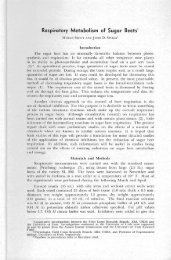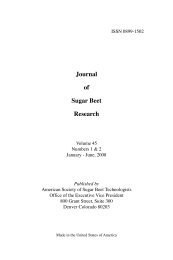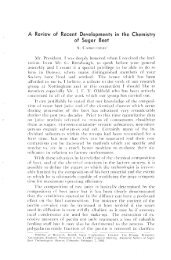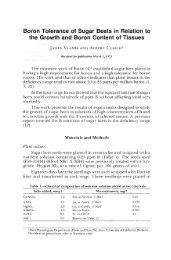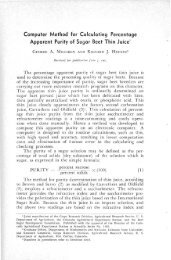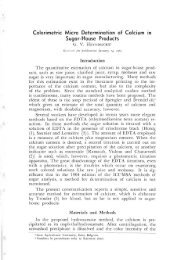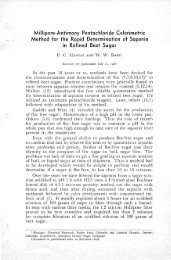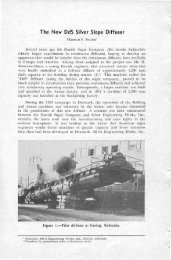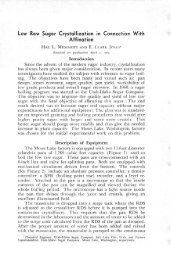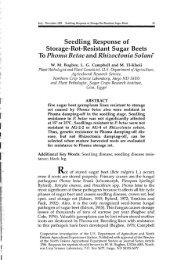Effect of Cossette Liming on Dewatering of Beet Pulp - Vol
Effect of Cossette Liming on Dewatering of Beet Pulp - Vol
Effect of Cossette Liming on Dewatering of Beet Pulp - Vol
You also want an ePaper? Increase the reach of your titles
YUMPU automatically turns print PDFs into web optimized ePapers that Google loves.
<str<strong>on</strong>g>Effect</str<strong>on</strong>g> <str<strong>on</strong>g>of</str<strong>on</strong>g> <str<strong>on</strong>g>Cossette</str<strong>on</strong>g> <str<strong>on</strong>g>Liming</str<strong>on</strong>g> <strong>on</strong> <strong>Dewatering</strong> <str<strong>on</strong>g>of</str<strong>on</strong>g> <strong>Beet</strong> <strong>Pulp</strong><br />
J. M. Randall, W. Camirand, E. M. Zaragosa<br />
Received For Publicati<strong>on</strong> April 20, 1981<br />
INTRODUCTION<br />
The increasingly high costs <str<strong>on</strong>g>of</str<strong>on</strong>g> energy are <str<strong>on</strong>g>of</str<strong>on</strong>g> great c<strong>on</strong><br />
cern to the sugar beet processing industry, since it is <strong>on</strong>e <str<strong>on</strong>g>of</str<strong>on</strong>g><br />
the most intensive c<strong>on</strong>sumers <str<strong>on</strong>g>of</str<strong>on</strong>g> energy in the food industry.<br />
Unger (13) estimated that <str<strong>on</strong>g>of</str<strong>on</strong>g> the over 2.6 x 10 6 Btu required<br />
to process <strong>on</strong>e t<strong>on</strong> <str<strong>on</strong>g>of</str<strong>on</strong>g> beets, approximately 25% <str<strong>on</strong>g>of</str<strong>on</strong>g> the energy<br />
is used to dry pulp, 4.5% to produce CaO, and 50% to cncen<br />
trate thin juice. Avlani, Singh, and Chancell (1) estimated<br />
23% for pulp drying and 44% for c<strong>on</strong>centrati<strong>on</strong> <str<strong>on</strong>g>of</str<strong>on</strong>g> thin juice.<br />
<str<strong>on</strong>g>Liming</str<strong>on</strong>g> beet tissue before extracti<strong>on</strong> <str<strong>on</strong>g>of</str<strong>on</strong>g> sugar could reduce<br />
energy requirements in <strong>on</strong>e or more <str<strong>on</strong>g>of</str<strong>on</strong>g> the major energy-c<strong>on</strong><br />
suming areas <str<strong>on</strong>g>of</str<strong>on</strong>g> beet-sugar producti<strong>on</strong>. It has been thought<br />
for many years that adding lime to sugar beet tissue might<br />
lower overall lime requirement in processing beet sugar, and<br />
a number <str<strong>on</strong>g>of</str<strong>on</strong>g> approaches to the problem <str<strong>on</strong>g>of</str<strong>on</strong>g> treating beets with<br />
lime prior to diffusi<strong>on</strong> have appeared to the literature. As<br />
early as 1905, Weinrich (15) proposed processing limed brei to<br />
remove sugar. Extensive tests <str<strong>on</strong>g>of</str<strong>on</strong>g> pressing juice from limed brei,<br />
as an alternative to diffusi<strong>on</strong>, were carried out by Borghi (5)<br />
and by B<strong>on</strong>elli (3, 4). Weinrich (16, 17) also proposed<br />
pressing brei or chips which had been limed and then neutral<br />
ized.<br />
A number <str<strong>on</strong>g>of</str<strong>on</strong>g> researchers have proposed diffusi<strong>on</strong> <str<strong>on</strong>g>of</str<strong>on</strong>g> cos<br />
settes combined with some form <str<strong>on</strong>g>of</str<strong>on</strong>g> lime treatment. Susic (12)<br />
proposed diffusi<strong>on</strong> <str<strong>on</strong>g>of</str<strong>on</strong>g> cossettes which had been treated with a<br />
mixture <str<strong>on</strong>g>of</str<strong>on</strong>g> lime and sugar, while Goodban and McCready (9)<br />
proposed treatment <str<strong>on</strong>g>of</str<strong>on</strong>g> cossettes with powdered lime followed by<br />
normal diffusi<strong>on</strong>, which Bobrovnik et al. (2) studied further.<br />
i< Western Regi<strong>on</strong>al Research Center, Science and Educatio n Administrati<strong>on</strong><br />
U.S. Department <str<strong>on</strong>g>of</str<strong>on</strong>g> Agriculture, Berkeley, California<br />
94710.
222 JOURNAL OF THE A.8.8.B.T.<br />
Lo<str<strong>on</strong>g>of</str<strong>on</strong>g> and Pohl (10) suggested in dilute<br />
water.<br />
to<br />
istics, Vukov and 14) studied <str<strong>on</strong>g>of</str<strong>on</strong>g> poor<br />
or<br />
in<br />
curred<br />
As<br />
cati<strong>on</strong>. Now,<br />
us take another<br />
is that<br />
drati<strong>on</strong> by<br />
by pressing<br />
<strong>on</strong><br />
with milk <str<strong>on</strong>g>of</str<strong>on</strong>g><br />
period when<br />
important<br />
characteristics. In this<br />
<strong>Beet</strong><br />
In<br />
Other forms <str<strong>on</strong>g>of</str<strong>on</strong>g><br />
mately<br />
pulp,<br />
EXPER IMENTAL<br />
research was not fo<br />
in beet-<br />
to , but<br />
<str<strong>on</strong>g>of</str<strong>on</strong>g>
VOL. 21, NO.3, APRIL 1982 223<br />
they proved greatly inferior to cossettes in reacti<strong>on</strong> to liming.<br />
<str<strong>on</strong>g>Cossette</str<strong>on</strong>g>s were cut in a pilot plant cossette cutter designed and<br />
c<strong>on</strong>structed in this laboratory. For liming c<strong>on</strong>diti<strong>on</strong>s at other<br />
than ambient temperature, the cossette cutter was chilled with<br />
ice or heated with hot water before use.<br />
<strong>Beet</strong> <str<strong>on</strong>g>Liming</str<strong>on</strong>g><br />
<str<strong>on</strong>g>Cossette</str<strong>on</strong>g>s were limed by <strong>on</strong>e <str<strong>on</strong>g>of</str<strong>on</strong>g> several methods:<br />
1) The cossettes were mixed with dry,powdered Ca(OH)2' either<br />
in a double c<strong>on</strong>e mixer or in a pill coater, for 2-3 minutes.<br />
Good c<strong>on</strong>tact <str<strong>on</strong>g>of</str<strong>on</strong>g> Ca(OH)2 with beet tissue was obtained in this<br />
time without excessive breakage <str<strong>on</strong>g>of</str<strong>on</strong>g> cossettes. The remainder<br />
<str<strong>on</strong>g>of</str<strong>on</strong>g> the total equilibrati<strong>on</strong> time was carried out at rest at what<br />
ever temperature was used.<br />
2) <str<strong>on</strong>g>Cossette</str<strong>on</strong>g>s were dipped into a thin slurry <str<strong>on</strong>g>of</str<strong>on</strong>g> Ca(oH)2 in thin<br />
juice (0.5-1.0%, calculated as CaO) for several minutes, then<br />
pulled out and drained. The remainder <str<strong>on</strong>g>of</str<strong>on</strong>g> the total equilibra<br />
ti<strong>on</strong> time was carried out at rest at the same temperature as<br />
the slurry.<br />
Shear and <strong>Dewatering</strong> Tests<br />
Shear tests were carried out with a 1. E. E. -Kramer Shear<br />
Press usually fitted with a 3000 lb proving ring. The standard<br />
cossette sample was 100g placed into a standard shear-com<br />
pressi<strong>on</strong> cell, with a power rate <str<strong>on</strong>g>of</str<strong>on</strong>g> travel <str<strong>on</strong>g>of</str<strong>on</strong>g> itt/sec.<br />
Static dewatering tests were carried out in two presses.<br />
For small samples and lower pressures, the Succulometer, a<br />
small hydraulic press made by the United Company, Westminster,<br />
Maryland, was used. It accepted 75g samples and cou1d apply<br />
a force 4450 Newt<strong>on</strong>s <strong>on</strong> a round die <str<strong>on</strong>g>of</str<strong>on</strong>g> 5.72cm inner diameter,<br />
for a pressure <str<strong>on</strong>g>of</str<strong>on</strong>g> 1730 KPa. For larger samples and higher<br />
pressures, we used a Carver Laboratory Hydraulic Press with<br />
a Cage Press attachment (Fred S. Carver, Inc. , Menom<strong>on</strong>ee<br />
Falls, Wis.). A total force <str<strong>on</strong>g>of</str<strong>on</strong>g> up to 44,500 N could be applied<br />
to a 8.89cm die, for a pressure <str<strong>on</strong>g>of</str<strong>on</strong>g> 5700 KPa.<br />
Other Analyses<br />
Total solids were determined by drying at 110 0 C for 16<br />
hours. Sugar analysis was carried out by first extracting the
224 JOURNAL OF THE A.s.s.B.T.<br />
sugar in ethanol by the Standard AOAC method followed by color<br />
imetric analysis <str<strong>on</strong>g>of</str<strong>on</strong>g> total sugar as recommended by Dubois et<br />
al. (8). Analysis <str<strong>on</strong>g>of</str<strong>on</strong>g> calcium was carried out by atomic absorp<br />
ti<strong>on</strong> using a Perkin Elmer 303 AA Spectrophotometer <strong>on</strong> samples<br />
prepared by a modified dry ashing method <str<strong>on</strong>g>of</str<strong>on</strong>g> Champman and<br />
Pratt (6).<br />
Sugar Extracti<strong>on</strong>s<br />
In preparing extracted pulp samples for dewatering tests,<br />
a number <str<strong>on</strong>g>of</str<strong>on</strong>g> methods were used to extract sugar. When the<br />
exhausted pulp was the desired product, samples <str<strong>on</strong>g>of</str<strong>on</strong>g> beet cos<br />
settes were placed in cheesecloth bags or in wire baskets and<br />
suspended in slowly flowing hot water for up to <strong>on</strong>e hour to<br />
completely extract the sugar. Also, many <str<strong>on</strong>g>of</str<strong>on</strong>g> the samples <str<strong>on</strong>g>of</str<strong>on</strong>g><br />
exhausted beet pulp were produced as a byproduct <str<strong>on</strong>g>of</str<strong>on</strong>g> extracti<strong>on</strong><br />
runs designed to produce typical raw juice in a bench scale<br />
type <str<strong>on</strong>g>of</str<strong>on</strong>g> semi-c<strong>on</strong>tinuous extracter using muiltiple c<strong>on</strong>tainers.<br />
Removal <str<strong>on</strong>g>of</str<strong>on</strong>g> sugar from the pulp was not quite as complete in<br />
this extracti<strong>on</strong> scheme as in the first method, but so far as<br />
could be determined, there was no difference in the nature <str<strong>on</strong>g>of</str<strong>on</strong>g><br />
the exhausted pulp.<br />
Shear Strength <str<strong>on</strong>g>of</str<strong>on</strong>g> Tissue<br />
RESULTS AND DISCUSSION<br />
It has been qualitatively stated in the literature (9) that<br />
liming beet tissue produces tougher pulp, which should be ad<br />
vantageous in dewatering pulp prior to drying. Shear strength<br />
tests <str<strong>on</strong>g>of</str<strong>on</strong>g> both extracted and unextracted cossettes c<strong>on</strong>firmed this<br />
over a wide range <str<strong>on</strong>g>of</str<strong>on</strong>g> process c<strong>on</strong>diti<strong>on</strong>s. Shear strength tests<br />
were carried out with both dry liming and wet-dip liming, and<br />
with several temperatures, equilibrati<strong>on</strong> times, and amounts <str<strong>on</strong>g>of</str<strong>on</strong>g><br />
lime. Table 1 summarizes the results for a few process c<strong>on</strong>di<br />
ti<strong>on</strong>s. Limed but unextracted cossettes were tougher than un<br />
limed c<strong>on</strong>trols from the same beet samples except at 33°C pro<br />
cess temperature; extracted cossettes were much lower in shear<br />
strength than initial samples, but pulp from limed cossettes was<br />
c<strong>on</strong>sistently much tougher than the c<strong>on</strong>trols. <str<strong>on</strong>g>Cossette</str<strong>on</strong>g>s limed<br />
(dry or dip) and equilibrated for 30 minutes were <strong>on</strong>ly slightly<br />
tougher than cossettes equilibrated for 15 min, indicating that
226 JOURNAL OF THE A.s.s.B.T.<br />
an equilibrati<strong>on</strong> time <str<strong>on</strong>g>of</str<strong>on</strong>g> 15 minutes is satisfactory. Shear<br />
strengths <str<strong>on</strong>g>of</str<strong>on</strong>g> extracted cossettes which had been equilibrated<br />
for 30 min before diffusi<strong>on</strong> were c<strong>on</strong>sistently about 10% tougher<br />
than those equilibrated for 15 min. Further, dipping for 6<br />
minutes instead <str<strong>on</strong>g>of</str<strong>on</strong>g> 3 minutes did not appear to increase the<br />
shear strength <str<strong>on</strong>g>of</str<strong>on</strong>g> extracted or unextracted beet tissue, and<br />
those results have been omitted.<br />
<strong>Dewatering</strong> <str<strong>on</strong>g>of</str<strong>on</strong>g> Limed <strong>Beet</strong> <strong>Pulp</strong><br />
The increase in toughness <str<strong>on</strong>g>of</str<strong>on</strong>g> limed cossettes vs. unlimed<br />
cossettes indicated that limed pulp might be easier to dewater<br />
by pressure than normal unlimed pulp, which is mushy. In<br />
current factory practice, extracted pulp from the diffuser is<br />
dewatered in large screw presses to about 22% solids, then<br />
dried in rotary kilns. Similar presses were not available for<br />
laboratory scale operati<strong>on</strong>, but simple batch pressing tests were<br />
made in an effort to approximate the effects <str<strong>on</strong>g>of</str<strong>on</strong>g> the c<strong>on</strong>tinuous<br />
presses. The Carver hydraulic press with a Cage Press Attach<br />
ment was preferred, for it could produce final moisture levels<br />
more in line with industry results than the lower pressure "Suc<br />
culometer" hydraulic press. Since some samples were so s<str<strong>on</strong>g>of</str<strong>on</strong>g>t<br />
that they could not be pressed in the Carver Press, Succolo<br />
meter tests were made <strong>on</strong> almost all samples to provide c<strong>on</strong>sis<br />
tency.<br />
Dry liming. The original procedure used for cossette liming<br />
was mixing cossettes with fresh, dry, powdered Ca (OH) 2' In<br />
early experiments <strong>on</strong> pectin deesterificati<strong>on</strong> (11), it was found<br />
that 1.0% lime (calculated as CaO) was sufficient to produce<br />
maximum pectin deesterificati<strong>on</strong>. It was also established that<br />
a total equilibrati<strong>on</strong> time <str<strong>on</strong>g>of</str<strong>on</strong>g> 15 minutes was more than suffici<br />
ent to allow OJ-!- and Ca 2 + to pentrate the cossette and react<br />
with the pectin.<br />
<strong>Dewatering</strong> results <strong>on</strong> dry-limed and extracted cossettes<br />
corroborated the belief that deesterificati<strong>on</strong> and calcium cross-<br />
linking <str<strong>on</strong>g>of</str<strong>on</strong>g> pectin would facilitate mechanical dewatering <str<strong>on</strong>g>of</str<strong>on</strong>g><br />
pulp. Table 2 shows the results <str<strong>on</strong>g>of</str<strong>on</strong>g> pressing limed and ex<br />
tracted beets in a Carver Press for 5 minutes at 5700 KPa.<br />
In all cases, the cosset'Les were mixed with powdered Ca(OH)2
VOL. 21, NO.3, APRIL 1982<br />
for and equilibrated<br />
<str<strong>on</strong>g>of</str<strong>on</strong>g> O.<br />
c<strong>on</strong>trol while with , water could<br />
for<br />
the<br />
period<br />
to<br />
21 0.0<br />
O.<br />
1<br />
227<br />
<str<strong>on</strong>g>of</str<strong>on</strong>g> the<br />
0.0 26.<br />
.5<br />
. 0 38 .<br />
1- .9<br />
0.0 25<br />
.5<br />
apparent there were significant am<strong>on</strong>g
228<br />
dip <str<strong>on</strong>g>of</str<strong>on</strong>g> , 6,<br />
not<br />
new<br />
or<br />
6 1<br />
JOURNAL OF THE A.s.s.B.T.<br />
10 5 14.<br />
7.1<br />
3 .6<br />
6 15 22.<br />
30 18.<br />
for 10 1700 o 4% lime<br />
.0<br />
<strong>on</strong>
230 JOURNAL OF THE A.s.s.B.T.
VOL. 21, NO.3, APRIL 1982 231<br />
firm, fresh beets because the precipitated calcium pectate would<br />
have more effect in strengthening the pulp <str<strong>on</strong>g>of</str<strong>on</strong>g> deteriorated beets<br />
than with firm, fresh beets. Perhaps this effect shows up to<br />
a limited extent in Figure 3, for beets held at 33 0 C are likely<br />
to s<str<strong>on</strong>g>of</str<strong>on</strong>g>ten somewhat. Additi<strong>on</strong> <str<strong>on</strong>g>of</str<strong>on</strong>g> lime to whole beets which had<br />
rotted has been advocated by Degtyar (7) as a means <str<strong>on</strong>g>of</str<strong>on</strong>g> im<br />
proved treatment.<br />
Energy C<strong>on</strong>siderati<strong>on</strong>s<br />
Perhaps the most important area for potential energy<br />
saving in liming <str<strong>on</strong>g>of</str<strong>on</strong>g> cossettes lies in more complete pulp de<br />
watering. Any additi<strong>on</strong>al mechanical dewatering that can be<br />
achieved through pressing limed pulp represents relatively low<br />
energy removal <str<strong>on</strong>g>of</str<strong>on</strong>g> water compared to c<strong>on</strong>venti<strong>on</strong>al water removal<br />
by evaporati<strong>on</strong> by c<strong>on</strong>tact with hot air. Comm<strong>on</strong>ly, the maxi<br />
mum dewatering that can be achieved industrially by pressing<br />
in screw presses is to a bout 78% moisture.<br />
Although equivalent screw presses were not available,<br />
the batch Carver hydaulic press gave comparable dewatering<br />
<str<strong>on</strong>g>of</str<strong>on</strong>g> c<strong>on</strong>trols when pressing was carried out at 5700 KPa for 5<br />
minutes (Table 2). In extracti<strong>on</strong> tests <strong>on</strong> cossettes which were<br />
dry-limed at 22°C, c<strong>on</strong>trols were dewatered to about 74.5%<br />
moisture. Thus, to obtain a dried pulp <str<strong>on</strong>g>of</str<strong>on</strong>g> 10% moisture from<br />
spent cossettes c<strong>on</strong>taining 96% moisture originally, another<br />
11.25 g H 2 0 must be evaporated from the 74.5% moisture pressed<br />
c<strong>on</strong>trols (per 100 g <str<strong>on</strong>g>of</str<strong>on</strong>g> original wet pulp). The same cossettes<br />
limed at 1.0% CaO equivalent were pressed to 56.':110 moisture;<br />
<strong>on</strong>ly 4.84 g <str<strong>on</strong>g>of</str<strong>on</strong>g> water would have to be evaporated Pt'r 100 g<br />
<str<strong>on</strong>g>of</str<strong>on</strong>g> original wet pulp to achieve the required 10% final moisture<br />
level. This represents <strong>on</strong>ly 43% <str<strong>on</strong>g>of</str<strong>on</strong>g> the heat energy required<br />
in the dryers under current c<strong>on</strong>diti<strong>on</strong>s. With wet-dip liming<br />
at 22 0 C with 2% lime slurry, c<strong>on</strong>trols could be pressed to a<br />
moisture c<strong>on</strong>tent <str<strong>on</strong>g>of</str<strong>on</strong>g> about 80.5%, while the lime pulp was<br />
pressed to about 63% moisture (Carver press). Using the same<br />
initial c<strong>on</strong>diti<strong>on</strong>s and calculati<strong>on</strong>s as in the previous example,<br />
16.05g <str<strong>on</strong>g>of</str<strong>on</strong>g> water would have to be evaporated from the c<strong>on</strong>trol<br />
compared to <strong>on</strong>ly 6.37 from the dip-limed sample as from the<br />
c<strong>on</strong>trol. Only 40% as much water would have to be removed
232 JOURNAL OF THE A.8.8.B.T.<br />
from the dip-limed sample as from the c<strong>on</strong>trol. Of course,<br />
pressing requires energy also, but any extra energy required<br />
for pressing the limed pulp to lower moisture would be small<br />
compared to heat energy for evaporati<strong>on</strong> <str<strong>on</strong>g>of</str<strong>on</strong>g> water from the<br />
pulp.<br />
<strong>Pulp</strong> drying currently requires about 25% <str<strong>on</strong>g>of</str<strong>on</strong>g> the total<br />
energy load <str<strong>on</strong>g>of</str<strong>on</strong>g> beet-sugar producti<strong>on</strong>. If suitable presses could<br />
be found to produce maximum dewatering <str<strong>on</strong>g>of</str<strong>on</strong>g> pulp, energy<br />
savings <str<strong>on</strong>g>of</str<strong>on</strong>g> at least 50% in drying operati<strong>on</strong>s could be obtained.<br />
This would amount to about 12% reducti<strong>on</strong> in total energy c<strong>on</strong><br />
sumpti<strong>on</strong> for beet-sugar producti<strong>on</strong>.<br />
Further energy savings from the modified process, such<br />
as reducti<strong>on</strong> in total amount <str<strong>on</strong>g>of</str<strong>on</strong>g> lime required, are discussed<br />
in other papers in this journal.<br />
SUMMARY<br />
A process modificati<strong>on</strong> c<strong>on</strong>sisting <str<strong>on</strong>g>of</str<strong>on</strong>g> c<strong>on</strong>tacting cossettes<br />
with either powdered or slurried Ca(OH)2' followed by a short<br />
equilibrati<strong>on</strong> period prior to diffusi<strong>on</strong>, can c<strong>on</strong>tribute to im<br />
portant reducti<strong>on</strong>s <str<strong>on</strong>g>of</str<strong>on</strong>g> energy c<strong>on</strong>sumpti<strong>on</strong> in dewatering and<br />
drying <str<strong>on</strong>g>of</str<strong>on</strong>g> exhausted pulp. It may be possible to achieve over<br />
all energy savings <str<strong>on</strong>g>of</str<strong>on</strong>g> up to 50% or more in pulp drying, repre<br />
senting a reducti<strong>on</strong> <str<strong>on</strong>g>of</str<strong>on</strong>g> up to 12-14% in overall energy c<strong>on</strong>sump<br />
ti<strong>on</strong> for the beet-sugar process.<br />
Additi<strong>on</strong> <str<strong>on</strong>g>of</str<strong>on</strong>g> lime to cossettes precipitates calcium pectate<br />
in place in the cell walls, toughening the pulp as well as pre<br />
venting degradati<strong>on</strong> and solubilizati<strong>on</strong> <str<strong>on</strong>g>of</str<strong>on</strong>g> pectin fragments into<br />
the raw juice. The toughened pulp allows much easie r and<br />
more complete mechanic al dewatering <str<strong>on</strong>g>of</str<strong>on</strong>g> the pulp in presses,<br />
greatly reducing subsequent need for heat energy in driers to<br />
dry the pulp for cattle feed. In some experiments, pressing<br />
<str<strong>on</strong>g>of</str<strong>on</strong>g> limed pulp, using batch hydraulic presses, removed suf<br />
ficiently more water that as little as 40% as much moisture<br />
would have to be evaporated from the pressed pulp as from<br />
similarly pressed c<strong>on</strong>trol samples. It is much less energy in<br />
tensive to remove water by pressing than by evaporati<strong>on</strong>, since<br />
no change <str<strong>on</strong>g>of</str<strong>on</strong>g> state is involved.
VOL. 21, NO.3, APRIL 1982<br />
(3)<br />
(5)<br />
(6)<br />
(7)<br />
(8)<br />
ACKNOWLEDGMENTS<br />
LlTERATU RE<br />
r
234 JOURNAL OF THE A.8.8.B.T.<br />
(10)<br />
(11<br />
French Pat<br />
(14 ) Vukov, K. a<br />
).<br />
( 16) <str<strong>on</strong>g>of</str<strong>on</strong>g><br />
<str<strong>on</strong>g>of</str<strong>on</strong>g> sugar beets.



